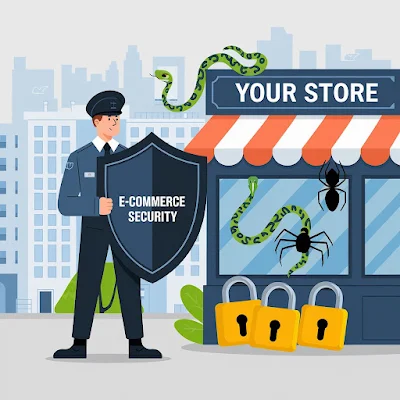Why eCommerce Sites Are Easy Targets for Hackers & How to Secure Them
Introduction
E-commerce has revolutionized the way of running businesses. However, there is an increased risk of digital expansion - cyberattack. Online stores are the main targets for hackers as they handle large amounts of sensitive data. Without proper security measures, businesses risk financial losses, reputational damage and legal consequences.
So why are e -commerce sites unsafe, and how can you protect your online store from cyber threats? Let's dive
Why Hackers Target eCommerce Sites
1. Valuable Customer Data
eCommerce platforms store sensitive data, which include credit card details, personal and login information. Hackers take advantage of weak security measures to steal and sell this data on the dark web.
2. High Transaction Volume
Continuous payment operations allow cybercriminals to perform card skimming and payment fraud activities that result in financial data theft. Businesses cannot react in time to unauthorized transactions when they do not monitor their systems in real time.
3. Weak Passwords and Authentication
Many eCommerce stores use weak or default passwords, making brute-force attacks easier. A lack of two-factor authentication (2FA) further exposes sites to unauthorized access.
4. Vulnerabilities in Third-Party Plugins
Additional functionality comes to eCommerce websites through third-party extensions that website owners depend on. Online vulnerabilities develop through plugins that remain outdated or lack necessary updates because these security gaps allow hacking attempts to enter..
5. DDoS Attacks Disrupt Business Operations
Distributed Denial-of-Service (DDoS) attacks flood websites with traffic, causing slowdowns or complete shutdowns. This disrupts sales and damages customer trust.
How to Secure Your eCommerce Store
1. Use SSL Encryption
The encryption offered by Secure Sockets Layer (SSL) protects all data exchanges between customers and your website. SSL encryption helps safeguard every piece of sensitive information that customers store across their accounts.
2. Implement Strong Authentication Measures
Use complex passwords and enforce password policies.
Both customer and administrator accounts must enable two-factor authentication (2FA) through advanced login procedures.
Update your login credentials regularly to prevent security threats.
3. Keep Software and Plugins Updated
Outdated platforms and plugins are easy targets for hackers. Regularly update your CMS, themes, and third-party plugins to patch security vulnerabilities.
4. Invest in a Web Application Firewall (WAF)
The implementation of a WAF creates a system that filters all website traffic to prevent dangerous activities from accessing your site. It defends websites from attacks that use SQL injection and cross-site scripting (XSS) together with numerous other digital threats.
5. Regularly Scan for Malware and Vulnerabilities
Frequent security audits and malware scans help detect threats which get immediately eliminated from your system. Use tools like:
Sucuri Security
SiteLock
Wordfence (for WordPress sites)





Comments
Post a Comment